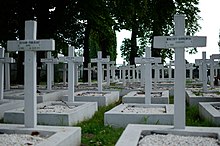Hrubieszów
Hrubieszów | ||
|---|---|---|
 Browar Sulewski - local brewery | ||
|
Car plates LHR | | |
| National roads | ||
| Voivodeship roads | ||
| Website | Official website | |
Hrubieszów (Polish:
Throughout history, the town's culture and architecture was strongly shaped by its Polish
History

The area formed part of the
In 1366, the area, along with Hrubieszów, then called Rubieszów, was eventually recaptured by King
After the

During the joint German-Soviet
After World War II, what remained of the town's
Between 1975 and 1998, the town was administratively part of the Zamość Voivodeship.
Jewish Community
The Jewish population numbered 709 in 1765, 3,276 in 1856, 5,352 (out of 10,636) in 1897, in 1921, there were 5679, and probably around 7500 in 1939.
During World War II, the German army immediately organized a series of pogroms after it invaded the town on 15 September 1939. Over 2,000 Jews, having experienced the Nazi German terror, left with the withdrawing Soviet army, which shortly occupied the town after 25 September 1939. On 2 December 1939, 1,000 Jews from Hrubieszów and 1,100 from Chełm were led on a death march to the

In June 1942, around 3,000 Jews from the ghetto were rounded up, some were killed in the town, and most were sent to the Sobibor extermination camp where they were all killed. The second deportation from Hrubieszów took place on 28 October 1942, when 2,500 Jews were deported to Sobibor and killed. Around 400 who resisted were executed at the Jewish cemetery and the last 160 Jews were sent to a forced labor camp in Budzyń.[6][7] About 140 of Hrubieszów 's Jews are thought to have survived. They were mostly those who had fled to Soviet controlled territory at the beginning of the war.
Jewish resistance
In the summer of 1941, Julek (Joel/Jakób) Brandt, a leader of the Zionist youth movement
Most of the Betar youth were killed in the spring of 1942 and in subsequent months together with the local Jewish population. A small number, however, managed to return to the ghetto and later took part in the Warsaw Ghetto uprising. Julek Brandt escaped from a transport heading for the Sobibor extermination camp. He was denounced by locals who tuned him over to the Gestapo in Hrubieszów. There he was put to work by Gestapo Obersturmbannführer Ebner, who named him chief of a small work camp on Jatkowa Street. At the end of 1942 or the beginning of 1943, Brandt was executed by Ebner.[8]
Transport
Heritage sights and monuments

Hrubieszów boasts a number of monuments:
- Birthplace of writer Bolesław Prus
- An outdoor sculpture of Bolesław Prus
- Saint Nicholas Catholic Church (17th-century)
- Orthodox church with 13 cupolas (1875)
- Madonna of Ceaseless Help Catholic Church (1903-5).
- Du Château manor complex, housing a regional museum.
- Madonna of Sokal Catholic Church.
- Jewish cemeteries (Old and New)
Sports
Unia Hrubieszów sports club is based in Hrubieszów, with football, athletics and weightlifting sections.
Notable people

Notable residents of Hrubieszów have included:
- Abraham Stern 1762-1842, inventor
- Yosef Almogi (1910–1991), member of the Israeli Knesset
- Bolesław Leśmian (1877–1937), poet
- Henry Orenstein (born 1923), toymaker, poker player, author, and entrepreneur
- Bolesław Prus (1847–1912), novelist
- Milton Rokeach (1918–1988), psychologist
Others with ancestry from the city include:
- David Mamet (born 1947), American playwright
- Zalman Shazar (1889–1974), third President of Israel
See also
References
- ^ "Polska w Liczbach". Data from Central Statistical Office (Poland). Retrieved 29 December 2016.
- ^ Beider, Alexander (2012). "Eastern Yiddish Toponyms of German Origin" (PDF). Yiddish Studies Today. ISBN 978-3-943460-09-4, ISSN 2194-8879 (düsseldorf university press, Düsseldorf 2012). Retrieved 26 December 2023.
- ^ "Remember Jewish Hrubieszów - Genealogy Group". chelm.freeyellow.com. Retrieved 7 June 2017.
- ^ "To był dla Chełma dobry rok". Super Tydzień Chełmski (in Polish). 10 November 2018. Retrieved 4 December 2021.
- ^ Wyzina, Władysław (1928). Zarys historji wojennej 5-go Pułku Strzelców Podhalańskich (in Polish). Warszawa. pp. 7–8.
{{cite book}}: CS1 maint: location missing publisher (link) - ^ Krakowski, Stefan. Jewish Virtual Library: Hrubieszow, Poland, Retrieved on 6 December 2013.
- ^ Megargee, Geoffrey (2012). Encyclopedia of Camps and Ghettos. Bloomington, Indiana: University of Indiana Press. p. Volume II, 634–636.
- ^ Libionka, Dariusz and Laurence Weinbaum, A New Look at the Betar 'Idyll' in Hrubieszów, Yad Vashem Studies, volume XXXVII (2009).
External links
- Official website of Hrubieszów
- Hrubieszów information service
- Hrubieszów Jewish genealogy site
- Official Hrubieszów County website


